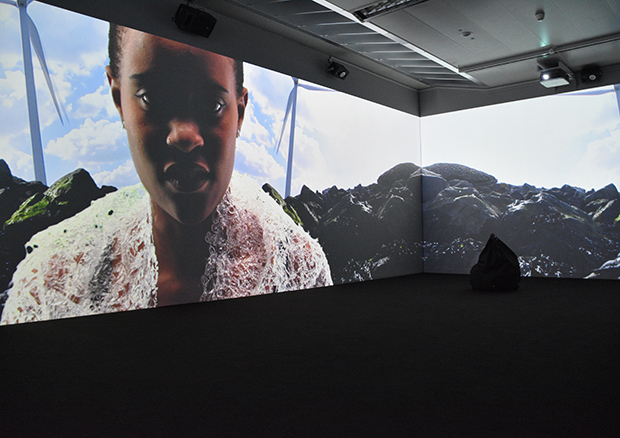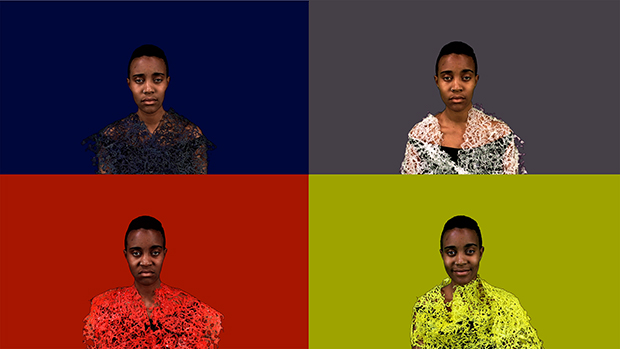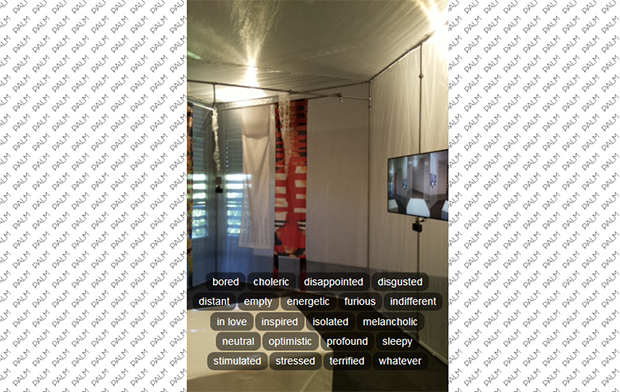Interview with U5: Talking about colours, emotions and sound
Cultural researcher Helene Romakin talks with the artist collective U5 and the sound composer Vivian Wang about their latest work «House of Sentiments» which was specifically produced for the République Géniale. This interview is a short version of the original text, which was published in the online magazine artfridge on August 15, 2018.

U5, House of Sentiments, 2018, 4-channel video installation, exhibition view, République Géniale, Kunstmuseum Bern, Photo: Kunstmuseum Bern
Helene Romakin: Could you describe your work in colours, smells, sounds, tastes, surfaces, etc…
U5: 5 things you can see: a drone, a dice, French fries, the moon and water; 4 things you can taste: red, blue, yellow and grey; 3 things you hear: a hiss, a chirp, a sigh; 2 things you can touch: wind and fibers; 1 thing you can smell: yourself
HR: The central piece of «House of Sentiments» is a video. Could you tell me more about its narration?
U5: Basically, there is no narration and there is no beginning and end. The video runs in a loop. It has highlights and moments to take a breath. The film carries the viewer through these moments, like a train of thought in which one thing fits the other and one no longer knows which thought was first and leads to the next. The projection screen is divided into four different pictures / emotions: The Red Room (angry), The Yellow Room (happy), The Gray Room (calm) and The Blue Room (sad). This division is leaned on Judy Chicago’s «All the colours of the year.» In this work she assigned emotions to colours, which we adopted, only the emotion «calm» we changed from purple to gray. Every room has an emotion, a colour, a fragrance, a sound, a symbol, an element. But there are also moments from time to time, in which one of these rooms takes on the entire projection surface. Each feeling has its own soundscape while all four mingle in the room to one. Depending on the visitor’s point of view, different moods arise.
HR: The work seems to merge from a mixture of art historical references, excerpts of existing texts, surveillance footage, studies on colour visions, and ultimately a product of all kind of associations made by the observer. To speak in musical terms, for me it is a challenging assemblage somewhere in between a cacophony and an euphony of senses. Did you plan this irritation from the beginning?
U5: Yes, no feeling is pure, it is always a mixture. How a situation affects feelings varies from person to person. It is impossible to trigger this specifically. Music has the ability to come closest to the emotions, to trigger them the fastest. That’s why the sound in the installation is very important. Vivian Wang has joined the voice and sounds to the picture.
HR: And yet, there is a common interpretation of certain ideas and studies of how people react to situations or colours…
U5: Yes, and simultaneously, we have to adapt our behaviour over and over again to the new living conditions. We are particularly interested in dealing with new technologies, with the digital and how they disturb our emotional balance. In the «House of Sentiments,» we influence the visitor by dragging, observing and involving him or her.
Vivian Wang: The music-colour association has been researched for eons, although we still haven’t come close to understanding what it is in our complex brain that does this. These connections are why you never see bright yellow or pink featured on the album cover art of a metal band or a dark blue or bloody red on a new age album cover. Colour has known collective emotional associations, although this may not be true across cultures. Amongst Europeans, the colour red is associated with danger, passion, excitement or revolution. In Chinese culture, red is entirely emblematic of good luck and happiness.

U5, House of Sentiments (video still), 2018, 4-channel video installation, © U5
HR: Vivian, how do you transform feelings into music?
VW: Music and colour have commonly accepted emotional qualities. As humans, we react to colour pretty much in the same way we react to sound. It may seem be nuanced or very dramatic depending on the incoming information and how we respond. Frankly, it’s not surprising that so much of our inner life is triggered by sound as well as colour. The same goes for smell. For «House of Sentiments,» the challenge wasn’t so much how to represent the sound of each colour, but how to present a spectrum of sonic attributes that correlated with a spectrum of emotions. The biggest challenge was to do this in a way that combines all four sound scores seamlessly and in a way that still worked as a whole without creating cacophony, unless the cacophony was intentional.
HR: Could you further evolve the idea of «flexible interpretation» you mentioned during a previous conversation. It implies that all characteristics of a «thing,» an idea or a thought are in a constant flux.
U5: If you take the emotions seriously, you can never feel like another person. But emotions come through and relate to other people. The colour conspiracies and associations are obvious, almost banal. They are based on socially embossed and learned perceptions, bodily functions. And yet they will trigger a different, specific memory in each one. Maybe they’ll take you to a place you almost forgot.
Regarding the flux: yes, we often take elements from earlier works bring them into a different form, so we also remember within the works. But we have also incorporated allusions to works by other artists of the exhibition «République Géniale.» For example, the flanking room shows the work «EINS. UN. ONE.» by Robert Filliou with coloured dices that have only one eye on each side. We loved them and put them in the movie. We chose the cube as a symbol for yellow, «Happy.»
HR: Let’s talk about the second part of the installation. Could you describe what expects the visitors there and how it is related to the first room?
U5: It’s a walk-in sculpture. Inside 3 webcams are aimed at a seat in the middle and a monitor is hung on one side. The visitor enters the room, is filmed from 3 sides and can look at the monitor a self-tryptichon. These pictures are streamed live on our PALM platform. Viewers from all over the world can imprint moods on these images. These are then displayed as subtitles and additionally change the colour of the pictures. The connections to the video room are multi-layered: the colours red, blue, yellow and gray appear again, flags hanging from the scaffolding carry texts that appear in the video, scraps of hot glue that the leading actress Khensani de Klerk wears in the video hang in the room. And here, too, the visitor decides for himself/herself how much he or she is involved in the installation in the factory. The degree of involvement interests us in immersive works. How deep do you dive? How much do you allow to happen? How much time do you spend in the installation?

U5, House of Sentiments, 2018, interactive multimedia installation, exhibition view, République Géniale, Kunstmuseum Bern, Foto: Dominique Uldry

PALM platform, screen shot, livestream at Kunstmuseum Bern, © U5
HR: What do you think of the role of chance and arbitrariness, associations and randomness, repetition and citation? Maybe, we can discuss it on the example of the constant re-occurrence of the «eye-motif» in your work?
When we formed the collective in 2006, one of our first and most important collaboration tools was to install a web cam in our shared studio. The «space-time-eye» (as we call it) gave us the opportunity to observe the dynamics of the collective from the outside.
The PALM project, which we have been working on since then, shows how essential it is for us to observe. It is not clear who is watching and who is being watched. The webcams have become mobile. We always carry cameras with us. And stream these images live on the internet, we redistribute these cameras to interested people and thus, open this platform to a broader public and try to build connections to other people.
The eye appears often in the video works because there, you can look without shame really long in the iris of a person. The digital eyes that look in the black mirror are everywhere and the 1:1 moments from human to human are increasingly rare.
They say: «The Internet does not forget,» and what about our retina? Does everything stay stored there once we have seen? Can it be overwritten? And will it only be deleted when we close our eyes for the last time?
HR: The exhibition at the Kunstmuseum Bern thematises the value of collaborations and collective practice. When and why did you decide on working together?
U5: We would like to ask this question the other way round. When does the solitary artist decide to work alone? That is not possible consistently. The artist always takes in the conditions and relationships of the world and processes them. The environment is a made, full of protagonists and stories and for the realisation of artworks one has always needed more than one person. Many artists work with big teams, but only one name is pushed into the outside world. Where does the different evaluation and hierarchisation of the work done come from when leads to an exhibition or a work? We are not concerned with anonymity, but with a pointed attitude towards the genius cult.
HR: Then let’s put the question differently. Could you talk more about your collaborative artistic practice
We do not actively distinguish who does what. It’s more like the one who can do it, does it. Sometimes we can do it all, then the one who starts it off and has the capacity works on it. However, it is not always clear what in the context «can» means. On the one hand, because of the background and the skills involved, on the other hand, because of time management, but above all, things are realized by being able to make the decisions that lead to the work. It’s not about perpetuating your own imagination, nor about making everything together at all costs. It is about the work and if something happens there what is exciting, what opens the eyes, then that is gratifying.
Links:
https://u5.92u.ch
https://palm.92u.ch/
Veröffentlicht unter Allgemein, République Géniale
Schlagwörter: Ausstellungen, Event, République Géniale, U5

